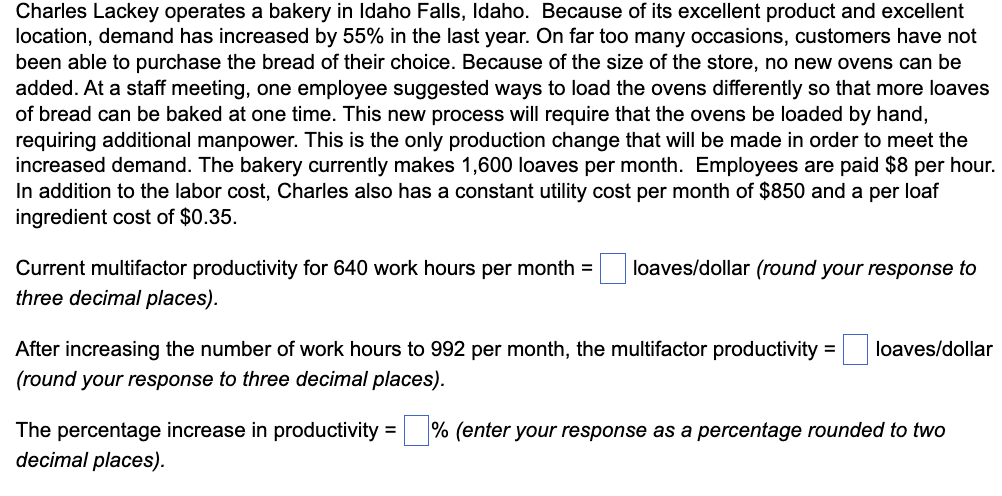Charles Lackey operates a bakery in Idaho Falls, Idaho. Because of its excellent product and excellent location, demand has increased by 55% in the last year. On far too many occasions, customers have not been able to purchase the bread of their choice. Because of the size of the store, no new ovens can be added. At a staff meeting, one employee suggested ways to load the ovens differently so that more loaves of bread can be baked at one time. This new process will require that the ovens be loaded by hand, requiring additional manpower. This is the only production change that will be made in order to meet the increased demand. The bakery currently makes 1,600 loaves per month. Employees are paid $8 per hour. In addition to the labor cost, Charles also has a constant utility cost per month of $850 and a per loaf ingredient cost of $0.35. Current multifactor productivity for 640 work hours per month = three decimal places). loaves/dollar (round your response to After increasing the number of work hours to 992 per month, the multifactor productivity = loaves/dollar (round your response to three decimal places). The percentage increase in productivity = % (enter your response as a percentage rounded to two decimal places).
Charles Lackey operates a bakery in Idaho Falls, Idaho. Because of its excellent product and excellent location, demand has increased by
55% in the last year. On far too many occasions, customers have not been able to purchase the bread of their choice. Because of the size of the store, no new ovens can be added. At a staff meeting, one employee suggested ways to load the ovens differently so that more loaves of bread can be baked at one time. This new process will require that the ovens be loaded by hand, requiring additional manpower. This is the only production change that will be made in order to meet the increased demand. The bakery currently makes
1,600 loaves per month. Employees are paid $
8 per hour. In addition to the labor cost, Charles also has a constant utility cost per month of $
850 and a per loaf ingredient cost of $
0.35.
Part 2
Current multifactor productivity for 640 work hours per month =
enter your response here
loaves/dollar (round your response to three decimal places).
Part 3
After increasing the number of work hours to
992 per month, the multifactor productivity =
enter your response here
loaves/dollar (round your response to three decimal places).
Part 4
The percentage increase in productivity =
enter your response here
% (enter your response as a percentage rounded to two decimal places).

Trending now
This is a popular solution!
Step by step
Solved in 3 steps with 2 images




